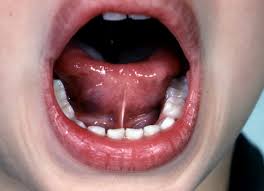 Ankyloglossia, also known as tongue-tie, is a congenital oral anomaly that may decrease the mobility of the tongue tip and is caused by an unusually short, thick lingual frenulum.
Ankyloglossia, also known as tongue-tie, is a congenital oral anomaly that may decrease the mobility of the tongue tip and is caused by an unusually short, thick lingual frenulum.
The frenulum is a membrane connecting the underside of the tongue to the floor of the mouth.
Ankyloglossia varies from mild cases characterized by mucous membrane bands to complete ankyloglossia whereby the tongue is tethered to the floor of the mouth.
Ankyloglossia can affect eating, breastfeeding, speech and oral hygiene.
Ankyloglossia has mechanical effects.
It can present social difficulties.
Some signs include difficulty speaking, difficulty eating, ongoing dental issues, jaw pain, or migraines.
Ankyloglossia can also prevent the tongue from contacting the anterior palate hampering the progression to an adult-like swallowing which can result in an open bite deformity.
This can also result in mandibular prognathism, when the tongue contacts the anterior portion of the mandible with exaggerated anterior thrusts.
Twenty-five percent of mothers of infants with ankyloglossia report breastfeeding difficulties.
Infants with ankyloglossia do not have such difficulties when feeding from a bottle.
Tongue-tie division may be a possible benefit for infants experiencing breastfeeding difficulties due to ankyloglossia.
Speech phonemes include sibilants and lingual sounds such as ‘r’ are likely to be affected.
It is possible for children with ankyloglossia to have normal speech in spite of decreased tongue mobility.
A large percentage of children with ankyloglossia will have articulation deficits that can be linked to tongue-tie and these deficits may be improved with surgery.
Ankyloglossia does not cause a delay in speech or language, but at the most, problems with enunciation.
There is no difference in speech sound development between children who received surgery, with a frenulectomy, to release tongue-tie, and those who did not.
Patients report that they thought that their speech was more effortful than other peoples’ speech.
Some believe that the tongue-tie contributes to difficulty in range and rate of articulation and that compensation is needed.
Even years following surgery, common speech abnormalities include mispronunciation of words: the most common of which is pronouncing Ls as Ws.
Mechanical limitations include cuts or discomfort underneath the tongue and difficulties with kissing, licking one’s lips, keeping one’s tongue clean and performing tongue tricks.
Social effects: embarrassment and teasing.
Ankyloglossia most often prohibits the tongue from resting in its ideal posture, at the roof of the mouth, which enables nasal breathing.
A consequence of ankyloglossia is chronic mouth breathing, which is correlated with other health issues such as enlarged tonsils and adenoids, chronic ear infections, and sleep-disordered breathing.
Ankyloglossia presence is correlated to bruxism and temporomandibular joint pain.
Normally the tongue rests at the roof of the mouth, it leads to the development of an ideal U shaped palate.
Ankyloglossia often causes a narrow, “V”-shaped palate to develop.
Such a palate crowds teeth and increases the potential need for braces and possibly jaw surgery.
Tongue restriction by the tightness of the lingual frenulum under the tongue
can influence other nearby parts of the body such as the neck causing muscle tightness and soreness and poor posture.
The diagnosis of ankyloglossia is not always apparent by looking at the underside of the tongue, but is often dependent on the range of movement permitted by the genioglossus muscles.
Elevating the tongue tip with a tongue depressor may reveal the problem, and making the tongue move to its maximum range will demonstrate the tongue tip restriction.
Palpation of genioglossus muscle on the underside of the tongue will aid in confirming the diagnosis.
Treatment:
Includes surgery in the form of frenotomy (frenectomy): a dental procedure may be done with soft-tissue lasers, such as the CO2 laser.
A small incision is made in the tissue and the tongue is freed from its tether.
Such surgery can be considered for patients of any age with a tight frenulum, as well as a history of speech, feeding, or mechanical/social difficulties.
An alternative to surgery for children with ankyloglossia is to take a wait-and-see approach, which is more common if there are no impacts on feeding: the frenulum naturally recedes during the process of a child’s growth between six months and six years of age.
